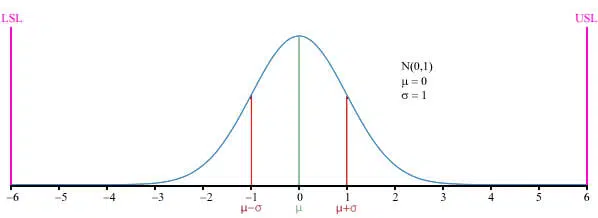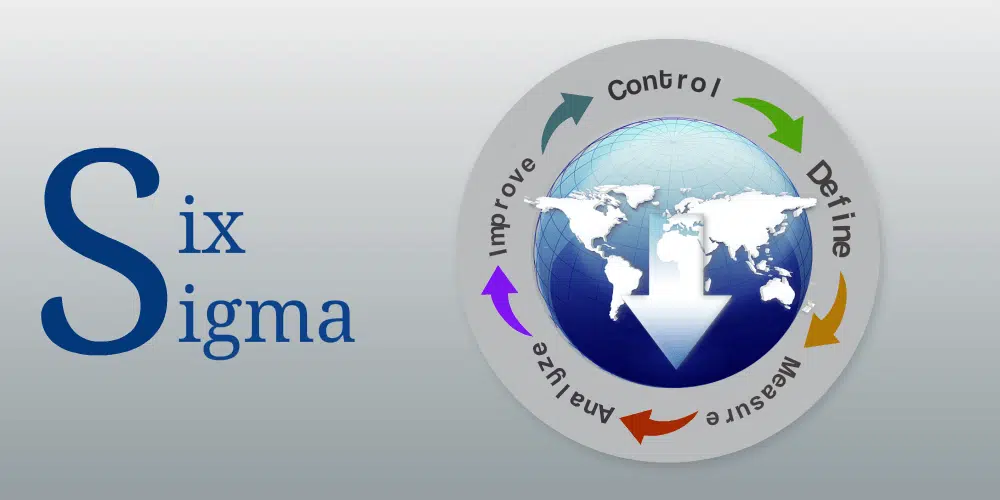Six Sigma is a popular methodology used in project management. It is a quality management methodology used to reduce defects and maintain product consistency.
Six Sigma is mentioned in the PMBOK Guide and included in the PMP Exam Content Outline, so you will see questions on this topic on your exam.
I see that many PMP exam reference books do not discuss this methodology. This is an important concept, and you should know it.
Six Sigma
Motorola developed Six Sigma in 1986 to remove the causes of possible defects from a process before it started.
This methodology was successful; GE adopted it and had excellent results. The fame of the Six Sigma methodology skyrocketed, and many manufacturing industries adopted it.
Six Sigma is a data-driven, customer-focused, and results-oriented product improvement methodology. The goal is to improve quality to the extent where only 3.4 failures per million are allowed or products have 99.9967% accuracy.
The chart below shows the Six Sigma graph.

This graph shows that Six Sigma is the six standard deviations on either side of the mean. LSL stands for Lower Specification Limit, and USL stands for Upper Specification Limit. Any measurement outside of these limits is considered a defect. The mean line is the target, and this is the ideal measurement.
Roles in the Six Sigma Organization
You can divide the Six Sigma roles into two segments:
- Initiative Leadership
- Project Leadership
These segments can further be divided into six categories:
- Six Sigma Executing Leadership or Deployment Leader
- Six Sigma Champions
- Six Sigma Master Black Belt (MBB)
- Six Sigma Black Belt (BB)
- Six Sigma Green Belts (GB)
- Six Sigma Project Team or Yellow Belt (YB)
Executive Leadership, Champions, and Master Black Belt are a part of initiative leadership. Black Belt, Green Belt, and Yellow Belt are a part of project leadership.
The Champion and Master Black Belt can be part of project leadership and initiative leadership.
Six Sigma Executing Leadership or Deployment Leader
Executing leadership includes project sponsors or top management. They are the ones who establish the business objectives, create the Six Sigma vision for the organization, and make sure everyone understands it.
Their active participation is mandatory for an organization to achieve the Six Sigma objectives. They hire Master Black Belts, Black Belts, and other top-level members to help them achieve the organization’s objectives.
Six Sigma Champions
Executive leadership selects Champions who are responsible for implementing Six Sigma. They manage Master Black Belts, Black Belts, and Green Belts. Champions work with these professionals to understand issues and provide support to resolve them. They manage the Six Sigma environment across the entire operative base.
Champions manage projects from a high level. They can distribute the projects in programs or develop a portfolio to manage them efficiently.
Six Sigma Master Black Belt
Champions select master Black Belts. They are responsible for project selection and human resource training. They train Black Belts and Green Belts.
Master Black Belts develop Six Sigma skills within the organization and ensure the sustainability of quality in the project.
They roll out Six Sigma methodologies on the project and ensure activity compliance. They mentor the project team and can engage with Deployment Leadership if any issues arise.
Six Sigma Black Belts
Black Belts execute and implement Six Sigma on the project and are part-time or full-time project team members.
They create the Six Sigma environment and challenge the status quo when there is resistance to implementing Six Sigma. They help utilize project resources, mentor the project team, including Green Belts, and share best practices.
Six Sigma Green Belts
Green Belts have fewer functions than Black Belts; they are involved with other project activities besides the Six Sigma activities.
They are sometimes called the “engine” of Six Sigma projects. They are responsible for daily Six Sigma activities, solving issues, calling for help if needed, and ensuring sustainable results.
Green Belts are responsible for their respective processes and have the authority to complete the work effectively. This is an essential aspect of the organization because Green Belts can build process improvement structures within each process.
They work at the project execution level, are responsible for Six Sigma results, and share best practices and lessons learned.
Project Team
Project Teams or Yellow Belts include project managers and team members. They are responsible for executing project activities. These people work with Green Belts or Black Belts to achieve the Six Sigma objectives.
These people are subject experts who support Green or Black Belts in developing the process maps and doing data capture for further analysis.
They don’t have to be Six Sigma certified but should be aware of Six Sigma functions.
Stakeholders in Six Sigma Projects
The following are the main stakeholders in any Six Sigma project:
- Customer
- Employee
- Supplier
- End users
Six Sigma Methodologies
You can achieve Six Sigma objectives by using two Six Sigma sub-methodologies:
- DMAIC
- DMADV
DMAIC helps you to improve the existing processes incrementally.
DMDAV helps you develop a new process or product. You can also use this methodology with existing processes when you need more than an incremental improvement.
What is DMAIC?
You can use this methodology alone or along with Six Sigma initiatives.
It is a structured problem-solving methodology where each phase depends on the successful completion of the previous one.
DMAIC stands for: Define, Measure, Analyze, Improve, and Control.
Define
Here, you define the customer and their problems, expectations, and requirements. You define the process with the help of a process map, identify the areas of improvement, define the Critical-to-Quality (CTQ) characteristics, set goals, define the project boundaries, and ensure that the required resources are available whenever they are needed.
Measure
Here, you measure the outcome and determine the process’s performance.
You draft a plan to collect reliable data from the process and determine the defects. This data should help you understand performance.
You may use customer surveys to find defects, improvement areas, or feature requirements. In this phase, the baseline performance is established. It helps you understand the process so you can take further steps to improve it.
Analyze
Here, you analyze the data collected in the measure phase and identify the issues that can affect your project or its outcome. You find the gap between the baseline and the current performance. You find the sources and take corrective action if there is a variation.
You also look for any opportunities and use them to improve your project.
Your main focus is to isolate the causes behind the Critical-to-Quality characteristics (CTQ). You also quantify the economic benefits of solving the problems.
Improve
Once you get to the root cause of the problem, you find a permanent solution and implement it to improve the process.
Here, you study the primary cause of the error and find ways to contain it. You develop and implement your new plan and a new method so that defects are stopped permanently. You measure the results after the implementation.
Control
This phase controls the process for stable performance and prevents the process from reverting to the “old way.” This is an essential phase for lasting results. You monitor the process, ensuring every approved change is implemented and followed.
What is DMADV?
DMADV helps you develop new processes or is used when the improvement through DMAIC is not up to the client’s expectations.
DMADV stands for Define, Measure, Analyze, Design, and Validate.
DMA is similar in both methodologies; however, the last two letters, “DV,” stand for design and validate.
In the design phase, you create the process or product that fulfills all Critical-to-Quality requirements. In the validation process, you check if all CTQs are as expected and that the final product meets or exceeds the customer’s expectations.
The Difference Between DMAIC and DMADV
Both Six Sigma methodologies aim to eliminate defects and improve the process; however, there is a difference between how and when you use them.
A few differences are as follows:
- DMAIC is used for existing processes, while DMADV is for a new process.
- DMAIC represents correction, and DMADV represents prevention.
- In DMAIC, Six Sigma focuses on a few CTQ, while in DMADV, Six Sigma focuses on all possible CTQs.
- DMAIC is usually a shorter duration, while DMADV takes a longer time.
Tools Used in Six Sigma
These Six Sigma tools are seven basic quality tools:
- Tally Sheet
- Flow Chart
- Histograms
- Cause and Effect Diagram
- Pareto Diagram
- Scatter Diagram
- Control Charts
Tally Sheet
The tally sheet is also known as the check sheet or checklist.
With a tally sheet, you record the data by marking it in real-time. You go to the location and observe the process and record it on a sheet. In most cases, you have to tick or cross it off.
Flow Chart
A flow chart is a diagram comprised of boxes connected with lines. This diagram shows you the workflow, process procedure, or algorithm. It helps you visualize the process flow and find issues or bottlenecks.
The flow chart is a useful communication tool and can help you study process improvement or document a process.
Histogram
A histogram is similar to a bar chart and displays the graphical distribution of numerical data. It is primarily used to show frequency distribution.
It helps you discover if a process change has occurred from one period to another. A histogram is an excellent communication tool to express data quickly.
Cause and Effect Diagram
This diagram is also known as an Ishikawa or fishbone diagram.
The cause and effect diagram helps you find possible causes for a problem. It helps you find bottlenecks in your process, such as why a particular process is not working.
Pareto Diagram
A Pareto Diagram is a bar chart. The longest bar is on the left, and the shortest is on the right side. The height of the bar decreases from left to right, and the chart displays the frequency of various errors.
You can focus on the most frequently occurring problems with the help of a Pareto Diagram.
Scatter Diagram
You use two variables in a Scatter Diagram: one is the dependent variable, and the other is the independent variable.
This diagram helps you determine the relationship between the two variables. You can predict the behavior of the other variable after determining the correlation between the two.
Control Charts
Control charts are used in quality management. These charts let you know if a process is stable.
This graph has the mean, lower control, upper control, lower specification, and upper specification limits.
The client sets specification limits, and any measurement outside of these limits are considered a defect.
Advantages of Six Sigma
Six Sigma helps organizations immensely; a few benefits of this methodology include:
- It is customer-driven.
- It covers the entire production process rather than just the outcome.
- It is a proactive process and helps you improve the process even before you discover your first defect.
- It improves quality, eliminates defects, and reduces waste, leading to more satisfied customers, which means more profit and brand recognition.
- There is a low variation in deliverables.
Six Sigma helps organizations save money by avoiding rework, scrap, return costs, and after-sale support.
Disadvantages of Six Sigma
There are no inherent disadvantages of this methodology; sometimes, it may not produce the desired result, or a delay may occur. A few examples of these situations are:
- Six Sigma works well for the production process but does not work for research (source).
- Sometimes, it may create rigid boundaries that could delay the process.
- Applying it to a small-sized company might be costly.
- According to some experts, 3.4 defects per million is too low, which may lead to putting more focus on areas with low yields.
- If top management is not supportive, Six Sigma will not give the desired result.
This was a brief introduction to Six Sigma, and I believe you now understand this methodology better.
Before I conclude this blog post, let’s discuss the differences between Six Sigma and the PMP certification.
Six Sigma Vs PMP
Six Sigma and the PMP certification do not compete with each other. Both certifications serve different purposes, though they interact with each other at some points.
The Six Sigma methodology mainly applies to the manufacturing and financial industries. The PMP methodology applies to all aspects of projects, regardless of industry.
Six Sigma focuses on eliminating defects and reducing waste, and it increases the quality of the product or the process. PMP concentrates on completing the project successfully.
The Six Sigma methodology is forced from top management down to operations, and active involvement from management is mandatory for its successful implementation. With PMP, it is usually an individual decision.
If you are undecided between these two certifications, I recommend you go for both. They complement each other and can make you more efficient and employable.
Conclusion
Implementing the Six Sigma methodology involves expense, especially in training and applying changes to the process. However, implementing it can bring fruitful results to organizations, such as profitability and brand recognition. The Six Sigma methodology must be implemented and monitored by top management. Their active involvement and support make it successful.
If you are interested in learning Six Sigma, you can join the Six Sigma courses offered by GreyCampus.

I am Mohammad Fahad Usmani, B.E. PMP, PMI-RMP. I have been blogging on project management topics since 2011. To date, thousands of professionals have passed the PMP exam using my resources.








Thank you so much for the information.
Do we need to cover the Six Sigma as part of the PMP??
You may see a simple question on Six Sigma.
Excellent information
Thanks Rosa for your comment.
Excellent post, thank you! Your blog is very helpful as I prepare for the exam.
You are welcome Jackie.
Thanks for the useful info
You are welcome Saleh.
Excellent lecture on SIX sigma….Now it’s clear that both certification PMP n SIX Sigma both r important, helpful n for better career n future…
Thanks Mohammad for your comment.
Your picture at the top of the page has the steps in the wrong order.
Thanks for pointing it out. It is corrected now.
Fahad: Good summarization and a good refresher for me. I bumped in to your blog while I was looking for critical path related information and I am glad to find it. Your PMP math problem compilation (even though a paid one), has helped me in solving few questions in the exam, key to pass the exam.
Keep doing the good work.
Regards,
Narendra
Thanks Narendra for your visit and leaving comment. I am glad that my eBooks helped you to pass the PMP exam.